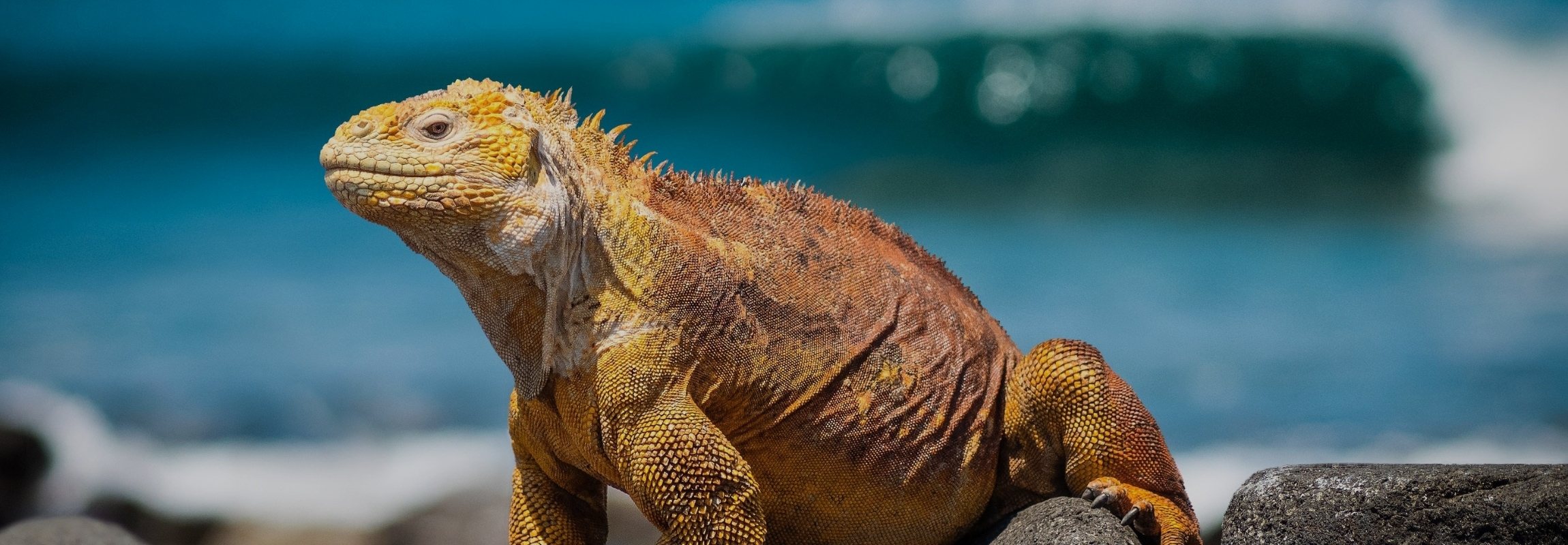
Galapagos Islands
Rebecca Adventure Travel offers authentic, affordable, and incredible Galapagos Islands tours. You can make a choice between cruises, island hopping or land-based tours, and diving tours. Below you will find general information about traveling to the Galapagos Islands to help you make the best choice for your Galapagos adventure.
Galapagos Islands General Information
The Galapagos Islands and tours consist of visiting 13 larger islands and many other small coves and islets. All of these Galapagos Islands are located in the Pacific Ocean, about 600 miles away from the Ecuadorian coast. In the Galapagos and the surrounding marine reserve, you can find plenty of special and unique animal species. That is because the unique natural processes of the ongoing seismic and volcanic activity, paired with the extreme isolation of the islands, have resulted in the development of extraordinary animal life in the Galapagos. Many of these wildlife species are endemic. This means they cannot be found anywhere else in the world! This marine reserve is a living museum and showcase of evolution. Also, in 1835, Charles Darwin was one of the first of many who visited the Galapagos, which contributed to the famous development of his theory of evolution.
Interestingly, every month has its own perks in the Galapagos. There are many Galapagos species that mate and reproduce at different times. During the entire year, there is something to see. Yet, even though the weather in Galapagos seems to be tropical, it can affect animal behaviors. With this calendar, you can see the highlights per month:
Galapagos Islands Tours: By Cruise or By Land
There are two ways to discover the Galapagos Islands; by boat on a cruise or on a land-based, island-hopping tour. Usually, island hopping tours are the more economical option. Find more information about the Galapagos Islands tours below:
Galapagos Island Hopping Tours – Land-Based
With an island hopping or land-based tour you will stay on one of the three main islands in the Galapagos Archipelago; Santa Cruz, San Cristobal, or Isabela, or all three! Guided excursions are available each day. In the evenings, you can stay at a comfortable hotel. A few examples of daily excursions are snorkeling, diving, hiking volcanoes, interpretation centers, and historical site visits. Transportation by water and on land is included. You can visit this page to see the different types of island hopping tours.
If you like diving the Galapagos Islands is one of the best spots in the world for diving, as stated by the PADI community. You can even take your whole PADI course at the Galapagos Islands. Check out one of our best-selling diving tours: the 7-Day Galapagos Diving.
Cruise Based Tours
At Rebecca Adventure Travel, you can find the best Galapagos Islands cruise tours. From tourist class to tourist superior, luxe, and first-class, you find all the boats for the best price. The main advantage of taking a cruise is that you travel at night and during the day you have the entire day to explore the most remote spots of the Galapagos Archipelago. A disadvantage is the limited space that you have on board (especially tourist and tourist superior class boats). The boats have a limited number of cabins (usually around 10). The cruises take from 4 up to 15 days and the starting points are either at Baltra or at San Cristobal airport.
Check out our last-minute cruise deals on the Galapagos Islands. Please contact us for more information and include the date range, preferred service level, and the number of passengers.
![]()
Pros of Island Hopping Tours
- Flexible departure dates accommodate tight schedules.
- Customizable land-based itineraries offer freedom and pace control.
- Economical option compared to Galapagos cruises.
- A great option for those who suffer from seasickness.
- Exclusive aerial perspective through inter-island flights.
- No rush; plan around personal preferences, including toddler schedules.
- Avoid pre-booking challenges during peak seasons.
- Experience each island’s unique charm at your own pace.
- Accommodates varying preferences for free days or structured tours.
![]()
Pros of Galapagos Cruises
- Efficient itineraries maximize island exploration.
- Ecological diversity and unique experiences on each island.
- Inaccessible islands like Fernandina and Genovesa are reachable.
- Inclusive meals eliminate the need to search for restaurants.
- Connect with naturalist guides for an enriching experience.
- Minimal cellphone coverage promotes quality time and unplugging.
- No nightly returns to hotels for a continuous island experience unpack just once.
- Established cruise schedules provide predictability and convenience.
Where to find wildlife in the Galapagos Islands?
The Galapagos archipelago is composed of 13 main islands and islets, of which 4 are inhabited and all others are pristine and wild. Interestingly, the species that inhabit these islands have many different physical variations, each unique to the island they reside on. Over millions of years, they adapted to their specific environments. Therefore, resulting in various species of Galapagos tortoises, finches, iguanas, and even birds that cannot fly. This is one of the principal reasons that led to Darwin’s theory of evolution by natural selection. Likewise, these same amazing animals have created the highest levels of endemism and biodiversity.
Discover here, where you can find all the unique animals that reside in the Galapagos Islands. Some are reached by island hopping or land-based tours, while others can only be reached by cruise.
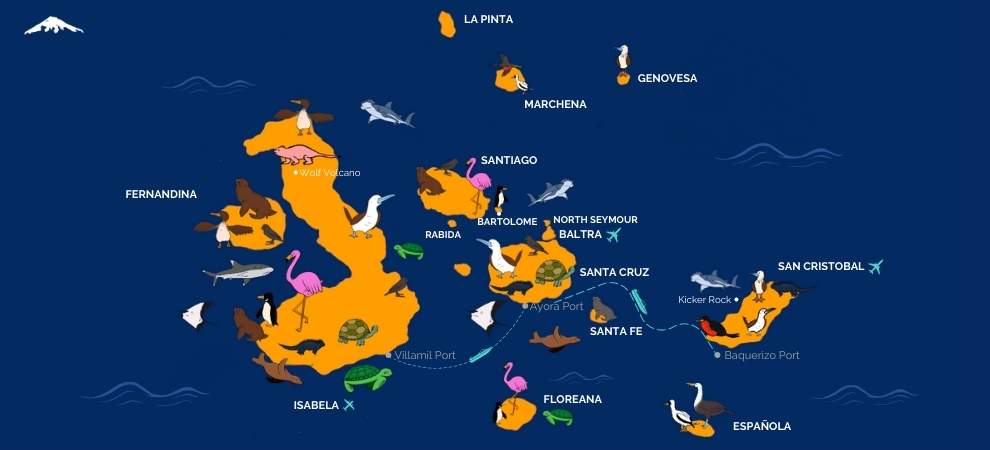
What To See of the Galapagos Islands Wildlife
Due to its wealth of wildlife, the Galapagos Islands are the perfect destination for animal lovers. The great thing about the animals in the Galapagos Islands is that they are receptive to your presence and have no fear. Therefore, your chances to see several animal species up close are high during our Galapagos Islands tours.
According to several scientists, the Galapagos Islands were never connected to the mainland. Therefore, the ancestors of every plant and animal species on the islands have come from somewhere else. Regardless of being separated by thousands of kilometers from the mainland, most of the Galapagos species were originally from North, Central, and South America, including the Caribbean. Land birds and California sea lions arrived from North America, and pink flamingos, and Darwin’s finches from the Caribbean. Whereas, land iguanas, pelicans, cormorants, and blue-footed boobies arrived from South America. As a result of the Humboldt Current, fur sea lions, and penguins were able to reach the Galapagos Islands as well.
Around the 1600s, humans started visiting the islands bringing plants and animals that otherwise never would have reached the Galapagos. In the 1800s people who settled in the Galapagos brought animals such as horses, cattle, donkeys, goats, pigs, dogs, and cats. Present-day only two of the nineteen islands remained untouched by introduced mammals. However, the introduction of new animals is still happening.
It is not a surprise that many species can be found in the Galapagos. Of course, due to the wealth of wildlife in the Galapagos Islands, it can be overwhelming trying to see them all. However, we can tell you what unique animals can be found with our Galapagos Islands tours and where. Keep reading below to find out!
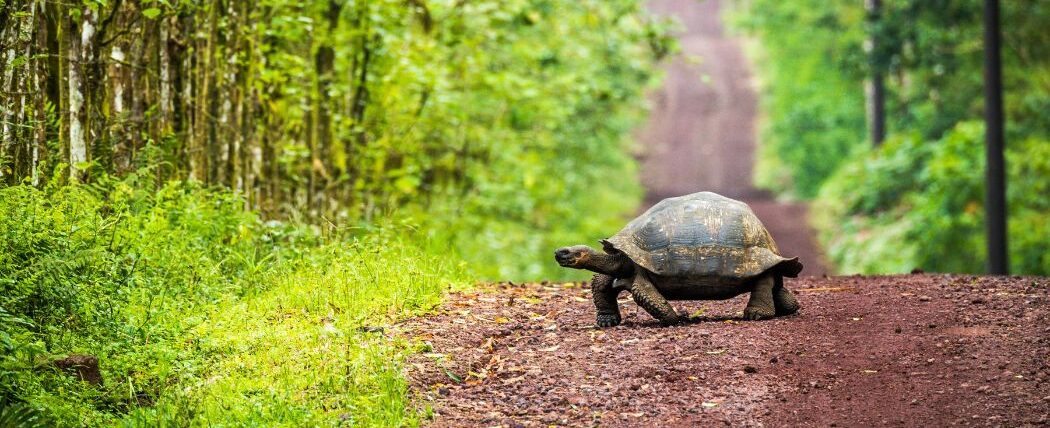
Galapagos Tortoises
The Giant Tortoise in the Galapagos is one of the most famous and unique species in the entire archipelago. Actually, the giant tortoises are so one of a kind that the group of islands was named after them. Galapagos means tortoise in Spanish, named so by Spaniards. They are the largest tortoises in the world and they are the longest-living species with an approximate lifespan of 170 years. An estimated 250,000 Giant tortoises once lived in the Galapagos just 200 years ago. Nowadays, you can find around 25,000 Giant tortoises on various islands.
Their diet includes grasses, leaves, cacti, fruits, and, in some cases, algae, reflecting their adaptation to the varied vegetation available across the different islands of the archipelago.
Find them in Santa Cruz at the Charles Darwin Research Station or the Santa Cruz Highlands. You can also see them on the island of San Cristobal at the Galapaguera de Cerro Colorado Breeding Center or in the wild on Floreana Island at Asilo de la Paz. Not to mention, as well as Isabela Island at the Arnaldo Tupiza Breeding Center or in the wild in the highlands.
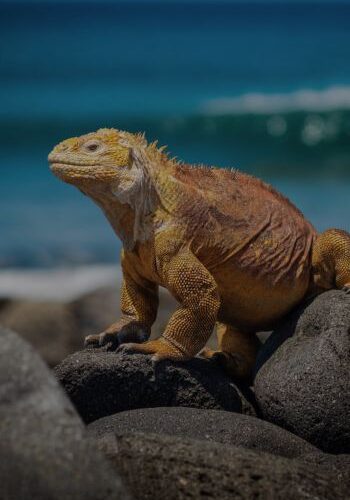
Land Iguana
In the Galapagos Islands, three land iguana species can be found, growing over 1 meter long and weighing above 13 kilos. Inhabiting drier areas, they typically reach maturity between 8 and 15 years.
Their diet includes vegetation, including cactus pads, fruits, flowers, and other plant materials.
Find them on Isabela Island, Fernandina Island, Santa Cruz Island, and South Plaza Island, these yellow-colored iguanas are called Conolophus subcristatus. Additionally, on Santa Fe Island, you can spot the Conolophus pallidus, while the Conolophus Marthae is exclusively found at Wolf Volcano at the Northern end of Isabela Island.
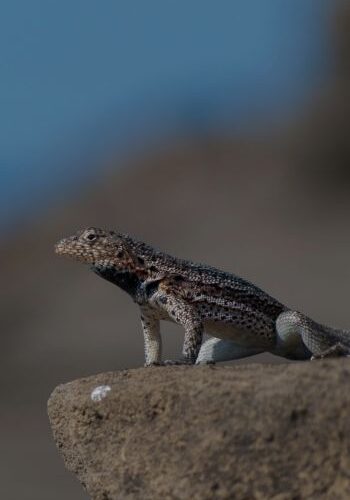
Lava Lizard
As one of the most abundant reptiles throughout the Galapagos Islands, lava lizards are small reptiles important to the Galapagos ecosystem. Normally, you can find lava lizards skirting across lava rocks. Coincidentally, the same place they got their name from. Male lava lizards tend to be brighter colors with yellow specks or gold stripes. On the other hand, females have a red throat or head. In addition, males are larger than females and have rougher skin.
Find them on every island except Genovesa, Darwin, and Wolf.
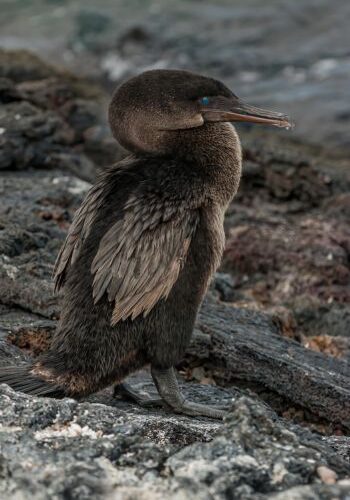
Flightless Cormorant
The flightless cormorant, or Galapagos cormorant, is a large blackish-colored bird that lost the ability to fly thanks to evolution. This makes them the only species in the cormorant family that does not fly, it is due to their tiny wings. When it comes to appearance males and females are similar. However, males are bigger than females.
Their diet includes octopus, eels, and bottom-dwelling fish as expert divers
Find them on only two islands in the Galapagos, Fernandina, and on the western coast of Isabela Island.
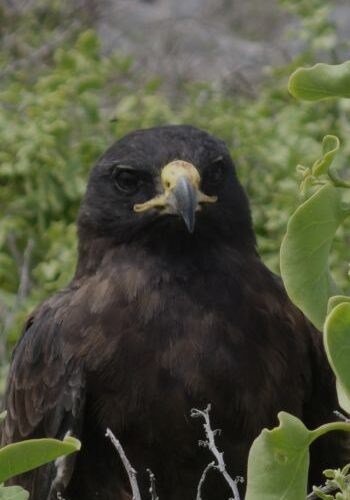
Galapagos Hawks
The Galapagos hawk, a prominent avian resident of the Galapagos Islands, is known for its distinctive appearance and behavior. This raptor, characterized by dark plumage and a keen gaze, is a non-migratory species, remaining on the islands year-round. With a wingspan of around three feet, it exhibits a strong territorial nature, typically residing in specific areas. These hawks play a vital role in the unique ecosystem of the Galapagos archipelago.
Their diet includes small animals such as lava lizards, insects, and even young iguanas.
Find them primarily on the Fernandina and Isabela Islands.
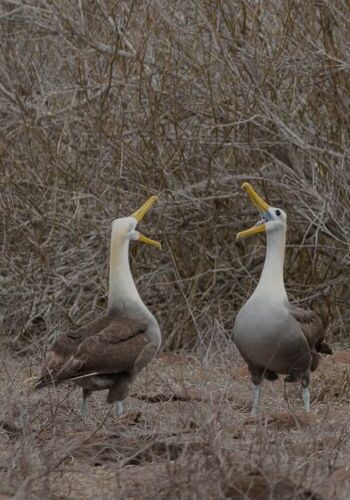
Waved Albatross
During a Galapagos Islands tour, you can learn about the waved albatross. Amazingly, it is the largest bird in the Galapagos Islands and the only albatross species found in the tropics. To further describe, the waved albatross has a white head and a bit of yellow on its crown and neck. The feathers are brown with white breasts and underwings. The waved albatross spends the majority of its life at sea and only lands to mate and reproduce.
Their diet includes feeding on squid at night.
Find them exclusively on Española Island.
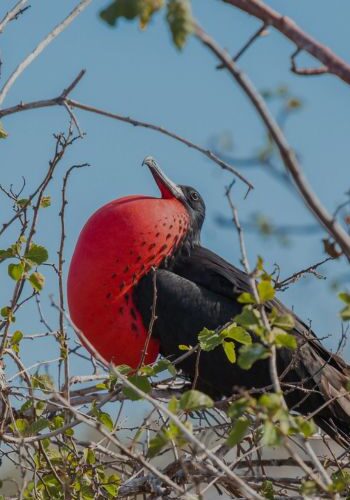
Magnificent Frigate birds
The magnificent frigatebird, nicknamed the “condor of the ocean” by Charles Darwin, is also known as the pirate of the Galapagos skies. With expansive wings, they effortlessly soar using thermals, reaching heights of 2,500 meters, minimizing wing flapping and enabling them to cover vast distances over tropical waters.
Their diet includes airborne flying fish, squid, jellyfish, and scraps discarded by boats. They also steal prey from other birds.
Find them on North Seymour, Floreana, San Cristobal, and Genovesa islands, as well as throughout the archipelago in mangroves, deciduous trees, and foraging over coral reefs
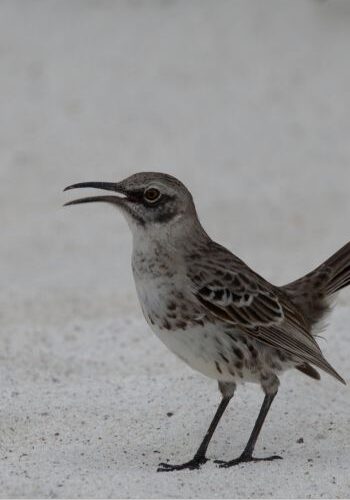
Galapagos Mockingbirds
The Galapagos Mockingbird might not be the most famous but it has had the greatest early influence on the theory of Natural Selection. There are four species of mockingbirds in the archipelago and the Galapagos mockingbird is the most widespread. The crown, nape, and tail are black and brown, and the wings are tipped with white. Whereas, the throat, chest, and belly are mostly white with flecks of brown.
Their diet includes fruits, nectars from cacti, small vertebrates, seabird eggs, and carrion.
Find them Santa Fe, Genovesa, Santa Cruz, Isabela, North Seymour, and Daphne Islands.
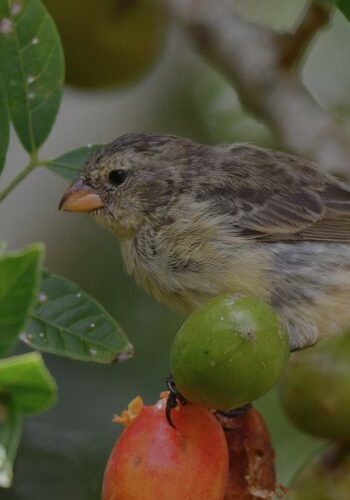
Darwin’s Finches
In the Galapagos Archipelago, you can spot 14 different species of Darwin’s Finches. As the name indicates, they are led so after the biologist Charles Darwin. The Finches are fearless and very noisy. All of Darwin’s finches have a similar size to a sparrow and they have a similar appearance with grey, brown, black, or olive-colored feathers. Even though the 14 different finches have the same appearance, they differ in size and habitat. The 14 different species of Darwin finches on the island also vary in their diet.
Their diet includes seeds whereas others eat insects.
Find them throughout the Galapagos Archipelago.
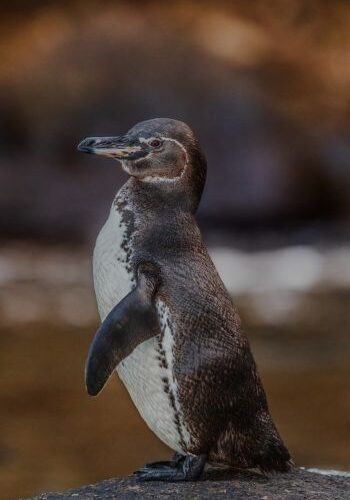
Galapagos Penguins
The Galapagos penguin, the world’s third smallest penguin, is unique for residing farther north than any other penguin species. Due to their smaller size, these penguins face numerous predators on land and in the water. Endemic to the Galapagos, they can’t be found anywhere else in the world. On land, their predators are crabs, snakes, owls, and hawks. In the water, they have to keep an eye out for fur seals, and even sea lions.
Their diet includes krill, small crustaceans, squid, and various fish species.
Find them near the western islands of Fernandina and Isabela, as well as Santiago, Bartolome, northern Santa Cruz, and the Floreana Islands.
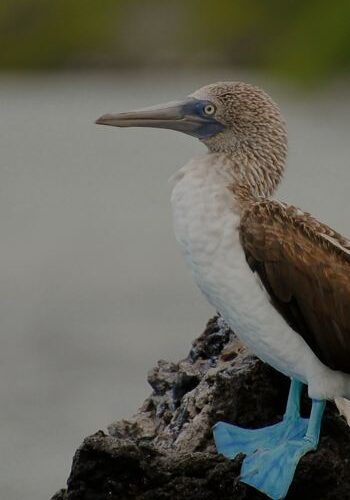
Blue-footed Boobies
The blue-footed booby is one of the most famous animals in the Galapagos. The name ‘Booby’ comes from the Spanish word bobo, meaning fool. This refers to the fact that the blue-footed boobies are a bit clumsy on land. Or, perhaps their awkward mating dance ritual! This seabird is large, comical-looking, and recognizable by its blue feet. Even though male and female boobies look similar, there are some differences. Females have a dark inner iris in the eye, which makes their pupils larger. In addition, the females tend to be a bit larger than the males but have shorter tails.
Find them at North Seymour, Isabela, Genovesa, San Cristobal, and Floreana Island.
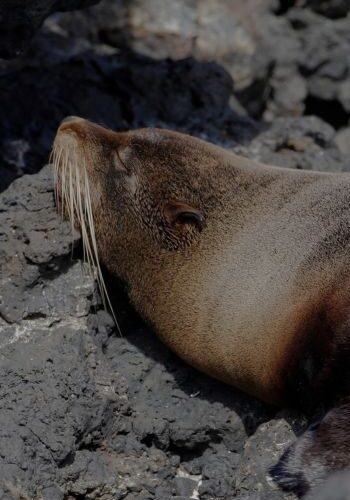
Galapagos Fur Seals
The Galapagos fur seal is endemic to the Galapagos Islands and it looks different than a sea lion with its short and small, button-like nose, while it has a fairly larges and the coat of the Galapagos fur seal varies from dark brown to dark grey with light-tipped, longer hairs that give a grizzly appearance. When doing so six to ten Galapagos fur seals can occupy a space of 100 square meters. They group up mostly because of the scarcity of suitable rocks, as well as for the benefit of making the females less vulnerable.
Find them on the rocky shores of the Galapagos near Santiago Island.
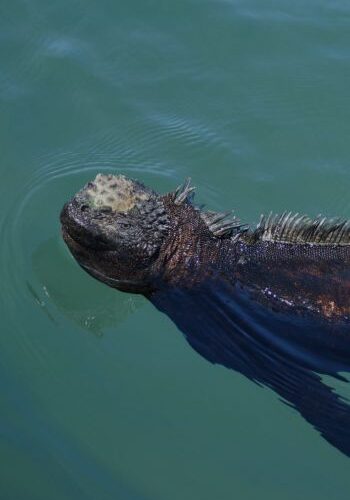
Marine Iguanas
In the Galapagos, seven marine iguana species exist: Albermalensis (Isabela), Cristatus (Fernandina), Hassi (Santa Cruz), Mertensi (San Cristobal and Santiago), Nanus (Tower), Sielmanni (Pinta), and Venustissimus (Hood). Distinguished by their flat nose and tail, these large, dark iguanas live both in and out of the water. Their adaptations include a flatter nose for algae-eating ease and a flatter tail for swimming. They can spend up to one hour underwater and take up to eight years to reach maturity.
Their diet includes feeding on marine algae, either from the splash zone or by diving near the shore.
Find them on every shore zone of the Galapagos Islands.







